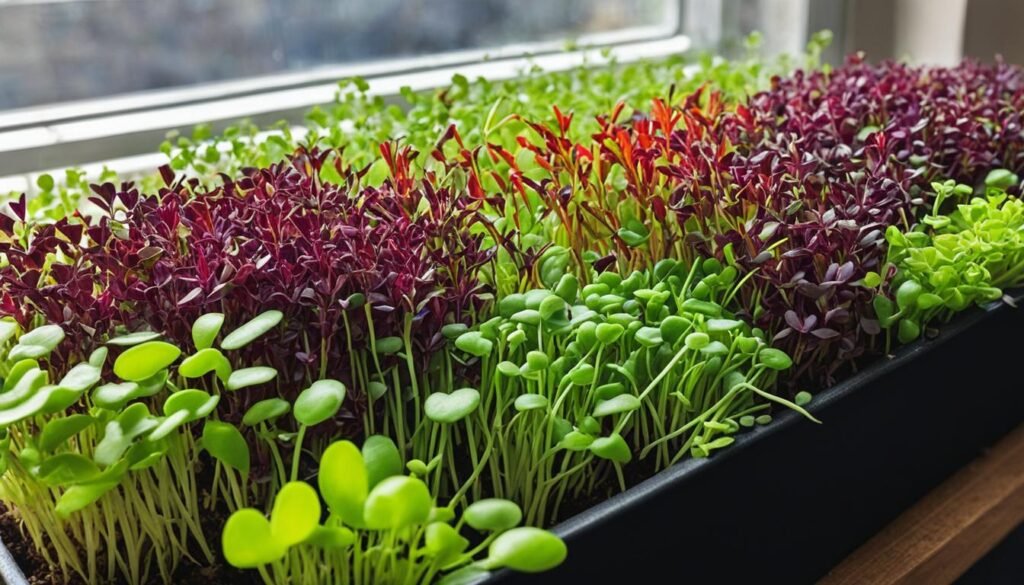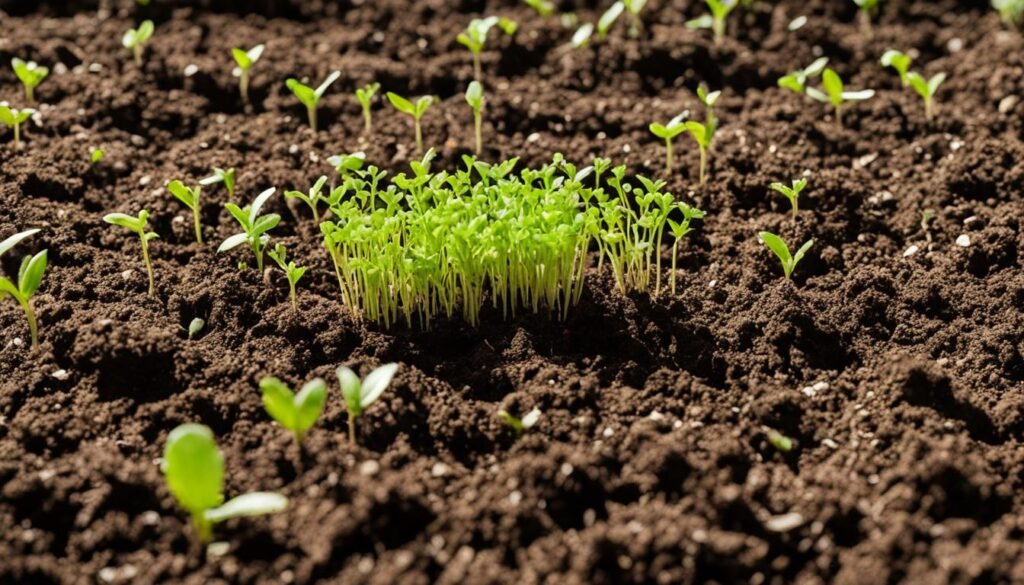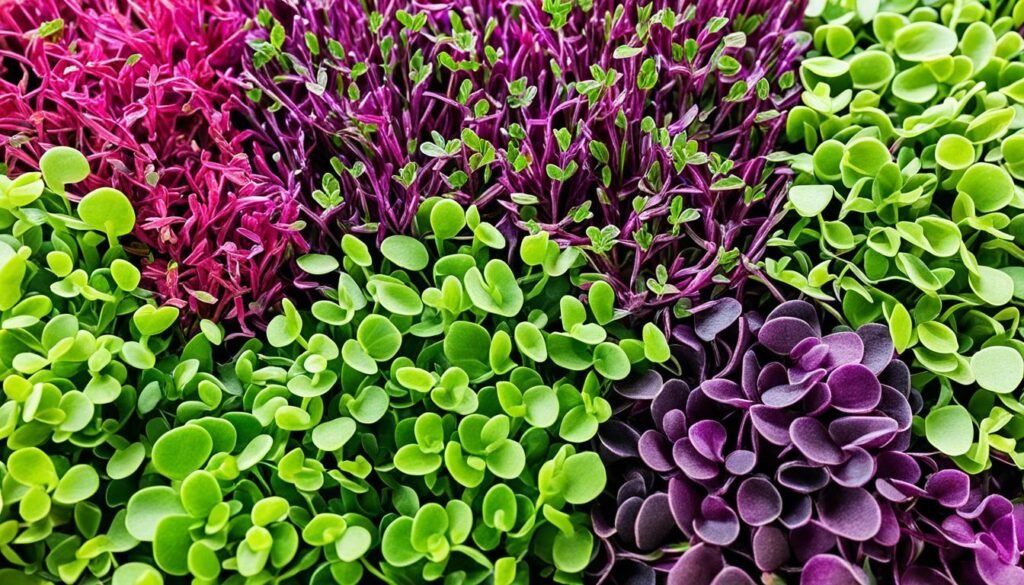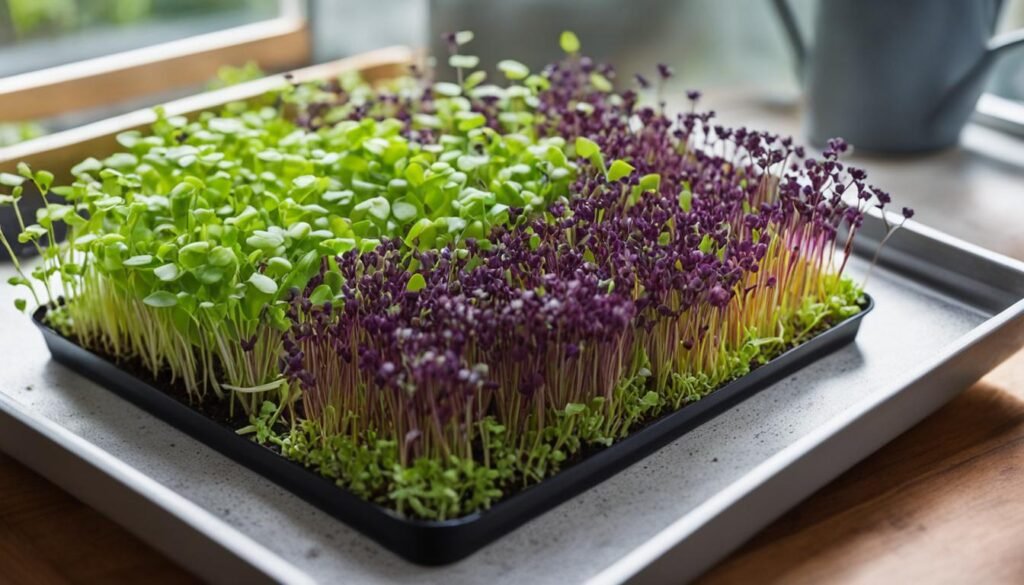Growing your own fast growing microgreens at home is an easy and convenient way to ensure a steady supply of fresh and nutritious greens. With the right tools and techniques, you can have a high-yield harvest of microgreens in a short amount of time. This article will guide you through the process of growing fast growing microgreens at home, providing you with all the information you need to get started.
Key Takeaways:
- Fast growing microgreens can be easily cultivated at home, ensuring a continuous supply of fresh greens.
- Microgreens offer numerous health benefits as they are nutrient-dense and packed with vitamins, minerals, and antioxidants.
- To grow microgreens at home, you will need microgreen seeds, growing medium, containers, water, and a spray bottle.
- Follow the steps of seeding, watering, and providing adequate lighting to achieve speedy microgreens cultivation.
- Choose quick growing microgreen varieties like radish, broccoli, cabbage, kohlrabi, and arugula for fast and abundant harvests.
The Benefits of Growing Microgreens at Home
Growing microgreens at home offers numerous benefits. Microgreens are thriving greens that are packed with essential nutrients, making them a healthy addition to your diet. Not only are they rich in vitamins, minerals, and antioxidants, but they are also fast maturing, meaning you can enjoy a fresh harvest of microgreens in just a few weeks.
One of the major advantages of growing microgreens at home is that they can be cultivated in limited space. Whether you have a small garden, a balcony, or even just a sunny windowsill, you can easily grow microgreens and have a constant supply of these nutritious greens at your fingertips.
Microgreens are known for their vibrant colors and delicate flavors, adding a burst of freshness to any dish. By incorporating microgreens into your meals, you can enhance both the visual appeal and nutritional value of your culinary creations.
With their fast maturation rate, microgreens provide a quick and convenient way to enjoy the benefits of homegrown greens. Unlike other plants that require months to grow, microgreens can be harvested and enjoyed within a matter of weeks, giving you a continuous supply of thriving, fast maturing microgreens throughout the year.
By growing your own microgreens at home, you can take control of your food production and ensure that you are consuming fresh, pesticide-free greens. Additionally, cultivating microgreens can be a rewarding and therapeutic hobby, allowing you to connect with nature and experience the joy of watching your plants thrive and flourish.
“Growing microgreens at home not only provides you with a steady supply of thriving, fast maturing microgreens, but it also allows you to embrace sustainable and eco-friendly gardening practices.”
So why wait? Start growing your own microgreens at home today and experience the multitude of benefits that these thriving greens have to offer.

What You Need to Grow Microgreens at Home
To grow fast growing microgreens at home, you’ll need a few essential items. Here’s a list of what you’ll need to get started:
- Microgreen seeds: Choose the seeds of the microgreen varieties you want to grow. Popular choices include radish, broccoli, cabbage, kohlrabi, and arugula. These varieties are known for their quick growth and rapid maturation.
- Growing medium or mat: Select a growing medium that can effectively hold soil moisture. This ensures that your microgreens receive the hydration they need for fast growth. You can use potting soil, coconut coir, or specialized microgreen mats.
- Growing containers or trays: Find suitable containers or trays to hold the growing medium and seeds. Plastic or wooden trays with drainage holes are commonly used for microgreen cultivation.
- Water: Provide your microgreens with regular watering. You can use a spray bottle to mist the seeds and growing medium gently.
- Sharp knife or scissors: Use a sharp knife or scissors for harvesting the microgreens once they have reached the desired size.
- Optional: Artificial lighting: While natural sunlight is generally sufficient for growing microgreens, you can supplement it with artificial lighting if needed. LED grow lights or fluorescent lights can provide the necessary light intensity for optimal growth.
With these basic supplies, you’ll have everything you need to start growing your own quick harvest microgreens at home. Once you’ve gathered the necessary items, you can move on to the next steps in the microgreen cultivation process.
How to Grow Microgreens at Home
Growing microgreens at home is a straightforward process that allows you to have a speedy microgreens cultivation and accelerated growth. By following these steps, you can enjoy a continuous supply of fresh and nutritious greens right from your own home.
- Calculate and Measure Seeds: Start by calculating the optimal amount of seeds needed for your trays. This will ensure that you have enough seeds for a successful harvest.
- Prepare Trays and Growing Medium: Fill your trays with the appropriate amount of soil or mat. This will provide a suitable environment for your microgreens to thrive.
- Seed Your Trays: Evenly distribute the chosen microgreen seeds on the surface of the growing medium. This will ensure that your microgreens grow uniformly.
- Provide Water: Water your microgreens with the right amount of water. This will keep them hydrated and promote their growth.
- Provide Suitable Environment: Keep your trays in a suitable environment for germination. This can be a warm and well-lit area in your home.
- Expose to Sunlight: As your microgreens start to grow, expose them to sunlight for proper photosynthesis. This will contribute to their accelerated growth.
- Ensure Proper Watering: Continuously water your microgreens to keep the growing medium moist. This will support their speedy cultivation.
- Harvest: Once your microgreens have reached the desired size, it’s time to harvest them. Use a sharp knife or scissors to cut them just above the soil or mat.
Following these steps will help you achieve efficient and successful microgreen cultivation at home. Now you’re ready to enjoy the rewards of your speedy microgreens growth and savor the freshness and nutrition they provide.

Tips for Successful Microgreen Cultivation
To ensure successful microgreen cultivation, there are a few tips to keep in mind. First, make sure to choose quick growing microgreen varieties that will reach harvestable size within a short period of time. This will allow you to enjoy a high-yield harvest of microgreens.
Second, provide your microgreens with the right amount of light and water. Proper lighting will promote healthy growth, while adequate watering will prevent under or overhydration.
Third, maintain a clean and hygienic growing environment to prevent the growth of mold or other contaminants. This is essential for the well-being of your microgreens.
Finally, pay attention to the temperature and humidity levels. These factors can greatly affect the growth of your microgreens. Aim to create an optimal environment for their development.
By following these tips, you can achieve successful microgreen cultivation at home. Happy growing!
Top Microgreen Varieties for Fast Growth
When it comes to fast growing microgreens, there are several varieties that stand out for their rapid growth and quick maturation. These varieties are perfect for home cultivation, allowing you to enjoy a speedy harvest of fresh greens. Here are some of the top choices for fast growing microgreens:
- Radish
- Broccoli
- Cabbage
- Kohlrabi
- Arugula
These microgreen varieties can be easily seeded and harvested within a short span of time, making them ideal for those who want quick and convenient cultivation. Whether you’re a seasoned gardener or just starting out, these fast growing microgreens can provide you with a continuous supply of fresh and nutritious greens.

Harvesting and Using Fast Growing Microgreens
Harvesting your fast growing microgreens is a simple and fulfilling moment in your journey of home cultivation. Once your microgreens have reached the desired size, you can bring out your sharp knife or scissors and gently cut them just above the soil or mat. Take care to harvest only what you need, leaving the rest to continue thriving and growing.
Fast growing microgreens are incredibly versatile and can be utilized in various delightful ways. The vibrant colors and fresh flavors they possess make them a perfect addition to a wide range of dishes. Add a handful of quick harvest microgreens to your salads, sandwiches, wraps, soups, and smoothies for an instant infusion of nutrition and taste. Get creative and experiment with different flavor combinations to elevate your culinary creations.
“The vibrant colors and fresh flavors of fast growing microgreens make them a versatile and nutritious addition to any dish.”
Incorporating harvested microgreens into your meals not only adds a pop of color but also provides essential nutrients. These thriving microgreens are abundant in vitamins, minerals, and antioxidants, promoting a well-balanced diet and supporting your overall well-being.

By harnessing the benefits of quick harvest microgreens, you can enhance the visual appeal, taste, and nutritional value of your dishes. Whether you are a seasoned chef or a passionate home cook, these fast growing microgreens invite you to savor the delightful possibilities they offer. Harvest and enjoy the wholesomeness they provide, and embrace the vibrant world of homegrown microgreens.
Troubleshooting Common Issues in Microgreen Cultivation
While growing microgreens is generally a straightforward process, you may encounter some common issues that can hinder the growth of your quick growing microgreens. By understanding and troubleshooting these problems, you can ensure the thriving development of your microgreens.
1. Overwatering
One common mistake is overwatering your microgreens. Remember that microgreens require moisture, but excessive watering can lead to root rot and mold growth. To prevent overwatering, make sure the growing medium is damp but not saturated. Allow the soil to dry out slightly between waterings.
2. Under or Overexposure to Light
Proper exposure to light is crucial for the successful growth of microgreens. Insufficient light can result in weak and leggy seedlings, while excessive light can cause wilting and even sunburn. Ensure that your microgreens receive the right amount of light by placing them in a well-lit area where they can receive indirect sunlight or using grow lights to supplement natural light.
3. Poor Seed Germination
Inadequate or inconsistent germination can occur due to factors such as low-quality seeds, improper planting depth, or suboptimal temperature and humidity levels. To promote successful seed germination, purchase high-quality seeds from reliable sources, follow the recommended planting depth provided on the seed packet, and maintain optimal growing conditions. Additionally, pre-soaking seeds overnight can enhance germination rates.
4. Mold Growth
Mold growth can occur in humid environments or when there is excess moisture in the growing medium. To prevent mold, ensure proper air circulation around your microgreens by using a small fan or ventilating the growing area. Avoid over-watering and keep the growing trays clean to minimize the risk of mold growth.
By addressing these common issues, you can troubleshoot any problems that may arise during the cultivation of your quick growing microgreens. Remember to maintain proper watering practices, provide adequate light, use high-quality seeds, and create a clean growing environment. These troubleshooting techniques will help your microgreens thrive and ensure a successful harvest of fresh and nutritious greens.
Conclusion
Growing fast growing microgreens at home is a rewarding and practical endeavor. With the right knowledge and techniques, you can achieve quick and successful microgreen cultivation, resulting in a continuous supply of fresh and nutritious greens.
By following the steps outlined in this article and choosing fast growing microgreen varieties, you can enjoy the benefits of homegrown microgreens and enhance your culinary and nutritional experiences. Start growing your own microgreens today and experience the joy of harvesting your own high-yield, fast maturing greens.
With a little effort and dedication, you can have thriving microgreens within a few weeks, ready to be used in your favorite dishes. Whether you’re a seasoned gardener or a beginner, growing microgreens at home is an accessible and rewarding way to add fresh and healthy greens to your meals. So why wait? Get started on your microgreen journey today and enjoy the satisfaction of growing your own nutritious and delicious greens.
Don’t miss out on the opportunity to grow your own fast growing microgreens and enjoy the numerous benefits they provide. From their rapid growth and high nutritional value to the joy of harvesting your own homegrown greens, microgreens are a fantastic addition to any home garden. Start your microgreen cultivation today and discover the delight of fresh, flavorful microgreens right at your fingertips.
Can the same method be used to grow other types of microgreens at home?
Yes, the same method can be used to grow other types of microgreens at home. For example, you can use the same step-by-step process for how to grow chickpea microgreens to grow other varieties such as broccoli, radish, or sunflower microgreens. It’s a versatile and simple method for home cultivation.
FAQ
Why should I grow microgreens at home?
Growing microgreens at home allows you to have a constant supply of fresh and nutritious greens. Microgreens are also perfect for limited spaces and have a fast maturing time.
What do I need to grow microgreens at home?
To grow microgreens at home, you will need microgreen seeds, a growing medium or mat, growing containers or trays, water, a spray bottle, and a sharp knife or scissors for harvesting. Natural sunlight or artificial lighting can also be used.
How do I grow microgreens at home?
Growing microgreens at home involves calculating the optimal amount of seeds, preparing the trays and growing medium, seeding the trays, providing water and suitable germination conditions, exposing the microgreens to sunlight, and harvesting when they reach the desired size.
What are some tips for successful microgreen cultivation?
Choose quick growing microgreen varieties, provide proper lighting and watering, maintain a clean environment, and pay attention to temperature and humidity levels.
What are the top microgreen varieties for fast growth?
Some of the top choices for fast growing microgreens include radish, broccoli, cabbage, kohlrabi, and arugula.
What are the nutritional benefits of fast growing microgreens?
Fast growing microgreens are packed with essential nutrients like vitamins, minerals, and antioxidants. They are a rich source of vitamins C and K, folate, and potassium.
How do I harvest and use fast growing microgreens?
Once your microgreens have reached the desired size, you can use a sharp knife or scissors to cut them just above the soil or mat. Fast growing microgreens can be added to salads, sandwiches, wraps, soups, and smoothies.
What are some common issues in microgreen cultivation, and how can I troubleshoot them?
Common issues can include overwatering, poor seed germination, mold growth, and under or overexposure to light. To troubleshoot, ensure proper watering, use high-quality seeds, maintain a clean growing environment, and provide the right amount of light.
How can I ensure a continuous supply of fresh microgreens?
By following the steps and tips outlined in this article and selecting fast growing microgreen varieties, you can achieve a continuous supply of fresh and nutritious greens.

